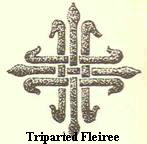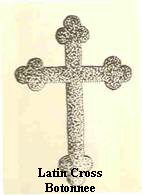|
|
 |
|
TheAgnus Dei – the Lamb of God with Banner of Victory.
Crown and Sceptre – kingly authority of the Lord
Cross and Crown – symbol of the Sovereignty of the Lord
Rosette – the Lord. Messianic Hope and Promise. Love
Pelican – ancient symbol of Atonement
Star of the Epiphany – associated with Christ and the Magi
The Cross Triumphant – is variously described as the Cross of Conquest or Victory. It symbolizes the Lord Glorified.
Wheat with Grape and Vine – the Holy Eucharist; the Body and Blood of Christ. Used for Holy Orders
Hammer and Nails – the Crucifixion
ove descending – the Holy Ghost. Head of the Dove overlapping the Cross from which three rays, representing the Trinity, emanate.
The Right Hand of God – a simplified symbol of God, the Father, where the Right Hand, in an attitude of benediction, is superimposed on a cross. The surrounding words, DexteraDomini, mean the Right Hand of God.
The Hand of God – Latin form used by Roman Catholic clergy and many of Protestant faiths. This symbol of Deity, is enclosed by a circle enriched with rays.
The Hand of God – Greek form. This position of the Hand simulates the letters IC XC which are contractions of the name Jesus Christ in Greek.
The Lord – the Hebrew letters for “Lord” surrounded by conventionalized “rays of glory”.
Jehovah – the Hebraic word for “Jehovah” enclosed in an equilateral triangle from which the “rays of glory” emanate to the perimeter of the circle symbolizing Eternity.
The Crown of Thorns
Maria – the monogram spells the name Maria, Latin for Mary. A popular symbol for the Mother of Jesus.
Mater Dei – the contraction of the words Mater Dei is frequently found in both ecclesiastical and commemorative art.
The Pierced Heart – a familiar symbol of the Blessed Mother. It is a solemn symbol of the sorrow suffered by the Mother.
Fleur-de-lys – the most common symbols of Mary, Mother of Jesus.
Madonna Lily – also LiliumCandidum, the symbol of the Annunciation and of Purity.
The Roman Lantern – the symbol of Betrayal
The Cross surmounting the Chalice – represents the Agony in Gethsemane
The Cross and Winding Sheet – represents the Descent from the Cross
The Empty Cross – another symbol of the Descent from the Cross – includes the remaining nails and Pilate’s inscription: Jesus Nazarenus Rex Iudaeorum
The INRI – “Jesus Nazarenus Rex Iudaeorum” placed by Pilate above the head of Jesus. The initials represent the Latin words for Jesus of Nazareth King of the Jews
Chi Rho with Alpha Omega – XP – contraction of the name Christ in Greek, one of the oldest Christian symbols. The letters Alpha and Omega are the sumbol of Him who said “I am Alpha and Omega, the beginning and end”
The Cross
The Cross is the predominant Christian symbol. The Latin Cross is the basic form and is sometimes referred to as the “True Cross” upon which Jesus was crucified. Down through the years, the Cross has assumed innumerable forms. These represent the most common artistic representations used across theMidwest in cemetery art. Today, the plain Latin Cross remains the most popular, while the other forms are rarely used.
The Lion – an attribute of Daniel, Hosea, Samson and David. It is used either in full form or only the head. It also is used to signify bravery.
The Yartzeit – the basin filled with oil upon which the lighted wick floats is a traditional commemorative ritual observed by the Jewish people; hence, the representation of this symbolical lamp on Hebrew memorials.
The Star of Davis – two interlaced equilateral triangles, symbolizing divine protection. Here it is surrounded by a circle symbolizing that divine protection throughout Eternity.
The Altar of Burnt Offering – also known as the Flaming Altar, is associated with ancient Hebrew ritual and often used on Jewish Memorials.
|
| [Home] [Stone] [Memorials] [Symbolism] [Symbolism Pictures] |












































 The Menorah – one of the most common cemetery art symbols of Judaism, the seven-branched candelabra commemorates the destruction of the temple erected by Solomon.
The Menorah – one of the most common cemetery art symbols of Judaism, the seven-branched candelabra commemorates the destruction of the temple erected by Solomon.
 The Ewer or Levi Pitcher – a symbol associated with the Levites who according to Scripture wash the hand of priests prior to religious service.
The Ewer or Levi Pitcher – a symbol associated with the Levites who according to Scripture wash the hand of priests prior to religious service.

